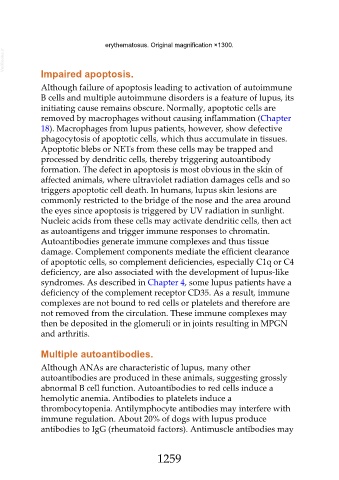Page 1259 - Veterinary Immunology, 10th Edition
P. 1259
erythematosus. Original magnification ×1300.
VetBooks.ir
Impaired apoptosis.
Although failure of apoptosis leading to activation of autoimmune
B cells and multiple autoimmune disorders is a feature of lupus, its
initiating cause remains obscure. Normally, apoptotic cells are
removed by macrophages without causing inflammation (Chapter
18). Macrophages from lupus patients, however, show defective
phagocytosis of apoptotic cells, which thus accumulate in tissues.
Apoptotic blebs or NETs from these cells may be trapped and
processed by dendritic cells, thereby triggering autoantibody
formation. The defect in apoptosis is most obvious in the skin of
affected animals, where ultraviolet radiation damages cells and so
triggers apoptotic cell death. In humans, lupus skin lesions are
commonly restricted to the bridge of the nose and the area around
the eyes since apoptosis is triggered by UV radiation in sunlight.
Nucleic acids from these cells may activate dendritic cells, then act
as autoantigens and trigger immune responses to chromatin.
Autoantibodies generate immune complexes and thus tissue
damage. Complement components mediate the efficient clearance
of apoptotic cells, so complement deficiencies, especially C1q or C4
deficiency, are also associated with the development of lupus-like
syndromes. As described in Chapter 4, some lupus patients have a
deficiency of the complement receptor CD35. As a result, immune
complexes are not bound to red cells or platelets and therefore are
not removed from the circulation. These immune complexes may
then be deposited in the glomeruli or in joints resulting in MPGN
and arthritis.
Multiple autoantibodies.
Although ANAs are characteristic of lupus, many other
autoantibodies are produced in these animals, suggesting grossly
abnormal B cell function. Autoantibodies to red cells induce a
hemolytic anemia. Antibodies to platelets induce a
thrombocytopenia. Antilymphocyte antibodies may interfere with
immune regulation. About 20% of dogs with lupus produce
antibodies to IgG (rheumatoid factors). Antimuscle antibodies may
1259

